Kristiansten Fortress
Get to know Kristiansten Fortress and its unique architecture and history!
You can access the map through QR codes placed around the fortress, using a QR code reader/scanner application on your phone.
Kristiansten Fortress is managed by the Norwegian Defence Estates Agency National Fortification Heritage.
Enjoy!
Donjonen
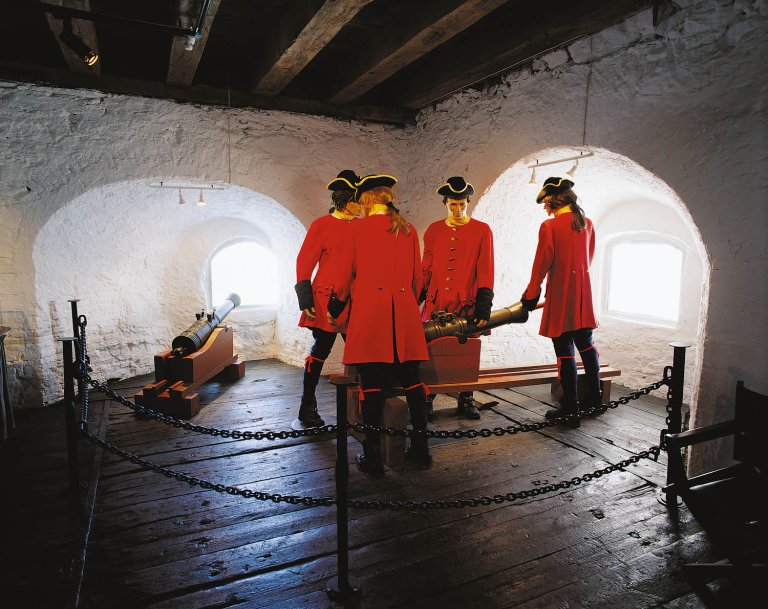
Kristiansten festning er en tårnfestning og ble oppført i 1682-84.
Tårnet der festningens hovedskyts er plassert kalles Donjonen.
Donjonen er festningens viktigste bygning. Tårnet har en asymmetrisk stjerneform med flere bastioner og batterier. En bastion er en flerkantet plattform for kanoner, mens et batteri er benevnelsen på artilleriets standplass.
Tårnet var en fullverdig liten befestning
Opprinnelig inneholdt tårnet alt en liten befestning skulle ha. Bygningen hadde kruttkjellere, leilighet for kommandanten og to etasjer med batterier med kanonstillinger og skyteskår.
Fra taket kunne vaktposten observere det meste av byen og festningens nærområde.
Andre eksempler på tårnfestninger er Munkholmen i Trondheimsfjorden og Citadellet på Stavernsøya. Men Kristiansten er Norges best bevarte tårnfestning.
Nytt liv på historisk grunn
I dag brukes Donjonen som museum og er åpen i sommersesongen.
Kongens bastion
Kongens bastion - et landemerke
Denne høye, monumentale spissen er sammen med Donjonen et arkitektonisk landemerke mot byen. Bastionen står i dag slik den ble bygget for 250 år siden.
Hva er en bastion?
En bastion er en flerkantet plattform for kanoner.
Bastionene på festningene kom som en følge av den militærtekniske utviklingen. Festningsmurene ble gjort rette med fremskutte plattformer for artilleriet.
Slik kunne kanonene treffe mål i en større vinkel enn om de hadde stått inne i murene.
Fra 1680-årene
Deler av Kongens bastion er fra Kristianstens opprinnelige befestning fra 1680-årene. I 1748 fikk verket? ny utforming i forbindelse med ombygging av større deler av festningen.
Restaurert
I perioden 2010 -12 ble muren mot sør restaurert. Deler av muren ble demontert og murt opp på nytt. Sementfuger ble erstattet med kalkmørtel.
Under arbeidet fikk man undersøkt hvordan den indre og bakerste delen av bastionen er konstruert. Det har ikke blitt gjort tidligere. Det ble påvist en definert murt vegg som er ca 1.5 meter på toppen.
Saluting at the fortresses
The saluting with cannons at Kristiansten Fortress take place at Kronprinsessens bastion. Ordinarily there are three cannons in a salute battery. Each cannon has a crew of two; one who loads and one who fires. The crew is from the home guard, and they carry the appropriate uniform. On weekdays the salute is at noon, while on Sundays it is at 1 p.m.
Commands
The salute commander heads the salute troop and gives the orders to fire the salute. He cries the cannon's number and “Fire!” (Ild) No other commands are used in this context. One fires from right to left in the firing direction.
Number of shots
Ordinarily 21 shots are fired. For important events in the royal family there is a double royal salute, which is two times 21 shots. In the case of deaths in the royal family, there is a 21 shot mourning salute. There is a gap of five seconds between the shots in an ordinary salute and a gap of 30 seconds between the shots in a mourning salute. In a double salute there is a one minute gap between the series.
The Royal Family is saluted
Dates for regular saluting:
- 21. February - H.M. King Harald's birthday
- 08. May - Liberation Day after WWII (1945)
- 17. May - Constitution Day (1814)
- 07. June - Dissolution of the Union with Sweden (1905)
- 04. July - H.M. Queen Sonja's birthday
- 20. July - H.R.H. Crown Prince Haakon's birthday
- 19. August - H.R.H. Crown Princess Mette-Marit's birthday
The Crown Prince's Bastion
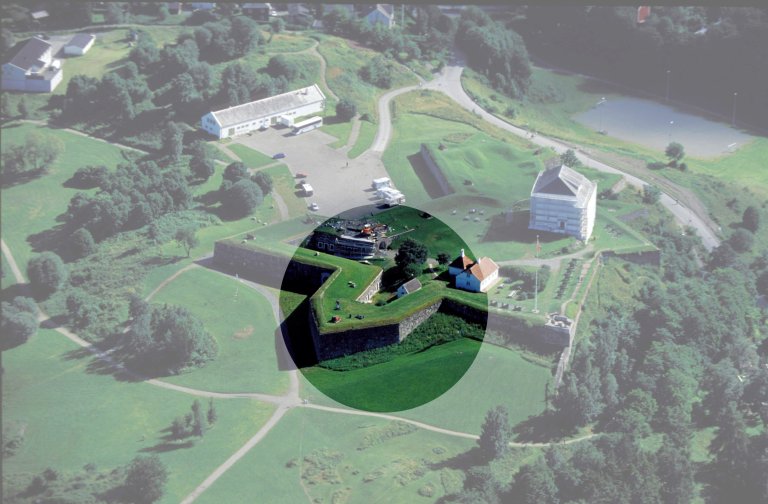
The Crown Prince’s Bastion is the northernmost part of the actual fortress.
It was built in 1745-48 when the fortress was extended.
This is the only completely ‘true’ bastion in the fortress, with four sides. The two sides at the front are called faces and the two to the rear are called flanks.
Well placed
The cannon were placed so they could cover the whole area outwards from all four sides of the castle wall, and from the sides to the next bastion.
View of Munkholmen
If you look out towards the fjord there is a splendid view of Munkholmen, which is mentioned by Snorre Sturluson and where there was a monastery until the Reformation.
The first defensive works were erected in the 1660s. From the 17th to the 19th century, the fortress was used as a state prison.
School building then and now
A bit closer to you to the north you can see the old barracks for the infantry training school. This building was erected in 1901 and has many fine architectural details in the art nouveau style.
The training school moved out in 2001. Since 2004 the building has housed St Thomas’ Christian free school.
Arnolds battery
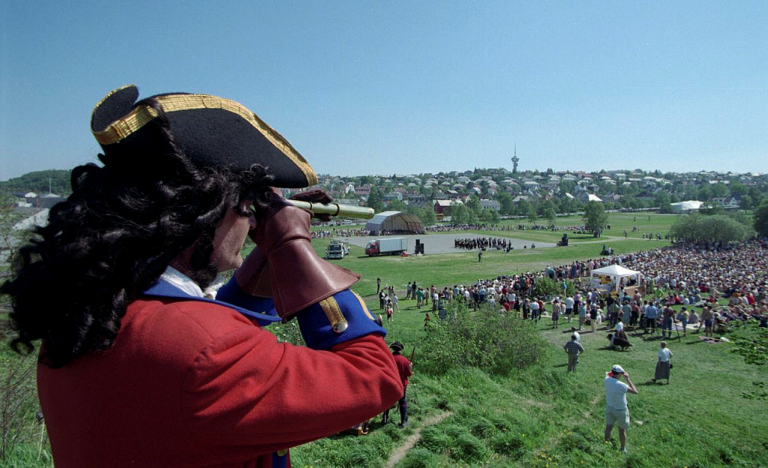
This part if the fortifications is called Arnold’s Battery.
It was built in 1745-48 when the original 17th century fortress was extended.
It is most likely named after Field-Marshall Hans Jakob Arnold, who was an officer in the Danish-Norwegian army. In the spring of 1718, Arnold and F. C. Cicignon were sent to Norway to “expedite and manage the doubling of the Norwegian national infantry regiment”, which had been assembled during the war.
Arnold occupied a prominent position
From 1736 until his death in 1758, Hans Jakob Arnold was commanding officer and inspector-general of the fortresses. In 1758, when he was 89 years old, he rode from Christiania to Trondheim. There he inspected the soldiers who were to be sent to Schleswig-Holstein to fight in the Seven Years’ War.
The Swedish army came from the east in 1718
Look towards the ridge in the east. This is where General Armfeldt arrived with his Swedish army to take Trondheim in 1718. The attack failed and the Swedes fled over the Tydal mountains. During the retreat they were overtaken by snowstorms and many died. Just 870 of the 5000 soldiers got back to Sweden.
The castle courtyard is now a cultural arena
In front and beneath you, you can see the castle courtyard. This is the forecourt of the original fortress. In the Second World War it was full of army huts (insert photo of these.)
Today the courtyard is an arena for cultural events. Part of National Fortification Heritage’s mission is to facilitate new use, and make the fortress accessible to the general public.
The double tenaille
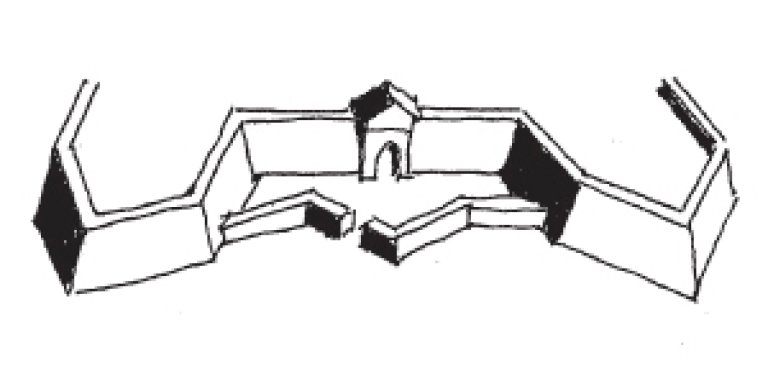
The Double Tenaille’ forms the whole southern section of the site and is among the oldest parts of the fortress, dating from the 1680s.
A tenaille is a defensive wall with concave angles, forming a star shape.
The Parade Ground
In front of you to the left is the Parade Ground, which was previously used for marching training but is now a place for drill displays.
Restoration of the walls
Kristiansten fortress has undergone thorough restoration in the last few years.
From 2009 to 2013, National Fortification Heritage spent more than 60 million kroner on repairs to the walls. The work was carried out with respect for historical accuracy and in close collaboration with the Directorate for Cultural Heritage.
Some 1500 square metres of wall have been restored. The ramparts have regained their correct historical profile and many of the buildings have been repaired.
Bulletproof room from World War 2
During the restoration work, an unknown casemate (bulletproof room) was discovered inside the wall you are now standing on.
The casemate was probably built during World War 2 from 1940-45 when the German occupation forces used the fortress.
At the western end of the tenaille are the preserved foundations for a searchlight that the Germans set up here.
The lower-lying tenaille
Projecting structure designed to protect the main fortress
A tenaille is a defensive wall with concave angles, forming a star shape.
The lower-lying tenaille was constructed in 1745-48 in order to provide the curtain wall (the straight inside wall) with extra protection.
During this period a considerable amount of rebuilding work was carried out on the northern front of the fortress.
Biological diversity
The fortress wall and the area below it serve as a habitat for plants and beetles which are currently rare species in Norway.
This area consists of dry slopes and knolls which are home to a great diversity of heat-loving species. It is also covered with meadow plants and scrub.
Vegetation of this type is currently considered to be threatened in Norway due to the demolition of such areas.
Rich plant and insect communities have also been found in the area, including several species of solitary bees.
Management plans
In February 2005 the Norwegian Defence Estates Agency and the municipality of Trondheim drew up plans for the conservation of the biological diversity at Kristiansten Fortress.
The area is now managed in accordance with these plans.
In 2006 the vegetation and soil was removed from an area of bedrock located on the western side of the wall. The natural growth in this area is being recorded.
The Casemates
Bombproof room inside the fortress walls
Look down at the fortress wall. You can see a number of door openings; these are the casemates (bombproof rooms).
The casemates were originally used as troop quarters, powder vaults and storerooms for the fortress. One of the rooms contained a well, and the smallest, closest to the main gate, was used as a prison.
The casemates were built in the 1740s when the fortress was extended.
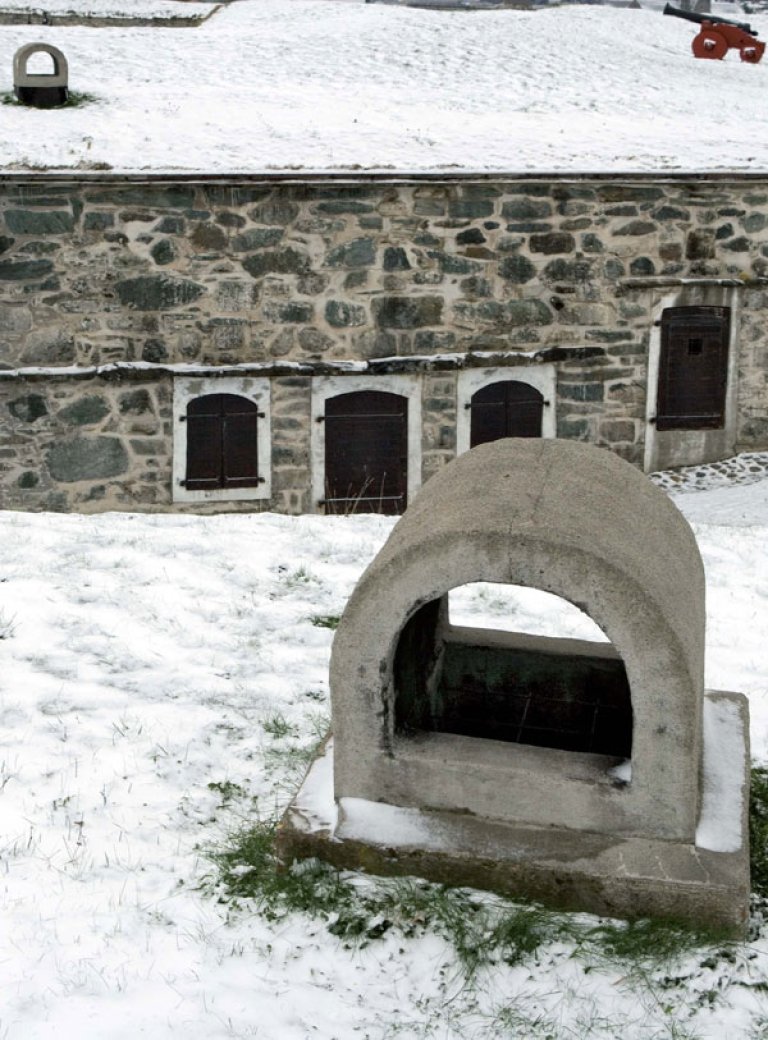
New life on historic ground – function rooms
The casemates have now been refurbished and put to new uses. Many of them can be rented as distinctive function or meeting rooms for courses or conferences .
The restoration was done by National Fortification Heritage as part of the work to equip the fortresses for “new life on historic ground”.
Ecumenical chapel
An ecumenical chapel was consecrated at the end of the 1990s in the casemates furthest in to the right.
In the Second World War, these casemates were used as detention cells for Norwegian resistance fighters before they were executed.
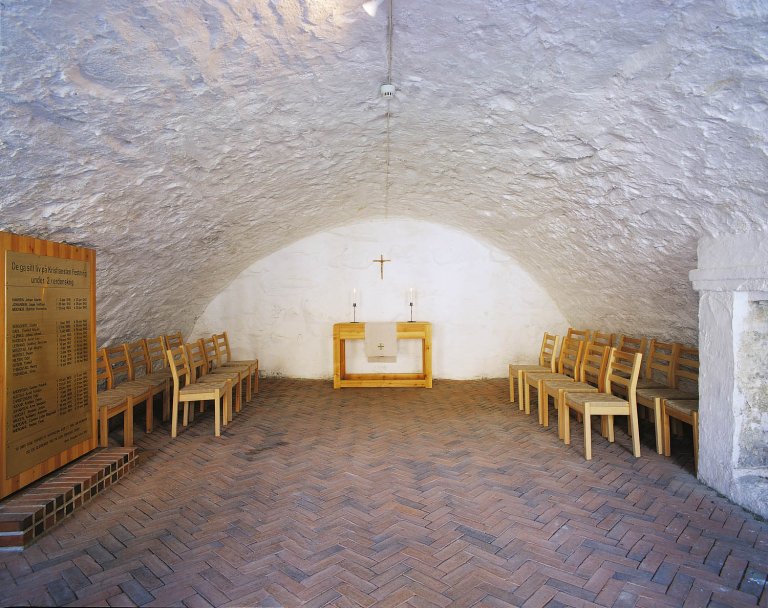
Place of execution
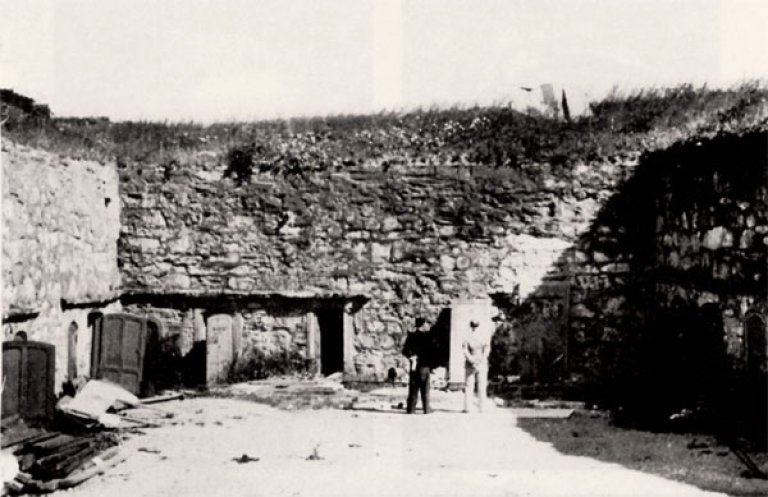
A grim chapter in the history of the fortress.
Kristiansten fortress was used as a place of execution in the Second World War. Some 30 Norwegian resistance fighters was executed between 1940 and 1945.
After the war, a number of war criminals were sentenced to death and executed here.
The actual place of execution is marked with a plaque on the wall.
The commandant's residence
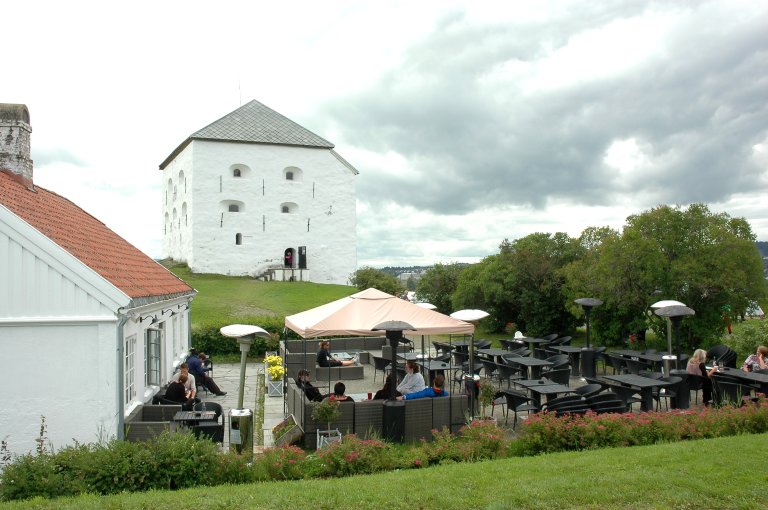
Once the commandant’s residence now a restaurant
This small building was erected in 1776-79 as a residence for the commandant of the fortress. The commandant was originally housed in the Keep (the tower), but moved into the commandant’s residence when it was completed in 1779.
Changing use over time
But the building has had other functions too. Among other things, it has been used as a munitions store and as a laboratory.
At the end of the 19th century the building also housed ‘crown workers’. These were men who had not paid maintenance for children born out of wedlock and were sentenced to forced labour for the army.
Until around 1995 the building was used as an officer’s residence for the Norwegian armed forces.
The commandant was a prominent figure in the local community
Along with their officers’ training, the commandants were often schooled in drawing, painting, dance and music. They often brought new skills and ideas to the communities they were posted to
The commandant’s residence is turned into a restaurant
Extensive restoration work started in 2004. All historical artefacts were thoroughly examined, and the rooms were renovated using traditional colours and materials.
Changes were also made so we now have a completely up-to-date little restaurant in the building.
Frølich's Redoubt
Remains of a small square redoubt
This small installation, the remains of which can be seen here, was built in 1691. The drawings of this installation were prepared by Cicignon/Coucheron who drew up the new town and fortification plans for the city of Trondheim during the 1680s.
What is a redoubt?
A redoubt is a projecting entrenchment from which guns can be fired at all angles.
Frølich's Redoubt was linked to the main fortress by a paved path. A "paved path" is a combined patrol path and firing stand for riflemen firing behind parapets and palisades.
Visible remains
You can see the remains of the walls on the top of Frølich's Redoubt. The parapets and mound which lie behind the walls are indistinct.
Haubitz Magazine
From gun store to distinctive reception premises
The Haubitz Magazine was built in 1918 in order to store Haubitz cannons. While ordinary cannons could fire straight ahead, Haubitz cannons were able to fire in a curve in order to hit targets behind fortress walls.
New life on historic ground
Today the Haubitz Magazine is being restored and refurbished so that it can be hired out for both large and small events.
From a prison to offices
During the 2nd World War the Haubitz Magazine was extended and rebuilt to create a prison with 56 cells. Several two-tier barracks were erected in the area surrounding the Magazine.
All the cells were demolished when the building was refurbished to serve as a storeroom and offices during the middle of the 1950s. The two-tier barracks have also now been demolished.
This building was not part of the actual fortifications. Use of the building shows typical military usage after the fortress ceased to be operational.
